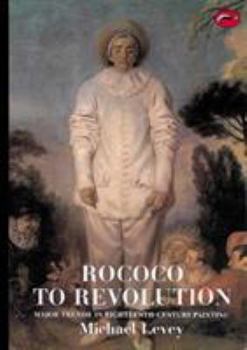Rococo to Revolution: Major Trends in Eighteenth-Century Painting
Select Format
Select Condition 
Book Overview
Michael Levey, former Director of the National Gallery in London, traces the major trends of European painting in the eighteenth century, taking as his theme the exciting evolution--and... This description may be from another edition of this product.
Format:Paperback
Language:English
ISBN:0500200505
ISBN13:9780500200506
Release Date:February 1985
Publisher:Thames & Hudson
Length:252 Pages
Weight:1.04 lbs.
Dimensions:0.7" x 5.9" x 8.3"
Customer Reviews
3 ratings
rococo!
Published by Thriftbooks.com User , 18 years ago
This is an awesome academic book. i wanted to know the history of rococo for a research paper and this was the first of many books i'm about to read. this book concentrates also on the history of france, spain, and italy so you can get a sense of where rococo came from and why rococo evolved. i read it in one sitting... 4 hours or so and there are images of works on every other page-spoiling the reader with so many relevant images. I had found some paintings that had interested me in the book and i tried looking for the images on google, but they were not available-so they must be obscure-but very good examples of the influential painters of rococo. it's fascinating to hear from a well versed author who is an expert on the time period in france. You can tell the author is at least bilingual in english and french, and being a francophone myself, it's nice to know someone's knowledge of a language is being put to good use to educate readers on art history.
A Rewarding Read
Published by Thriftbooks.com User , 23 years ago
Some time ago I tried to read this book, but put it away after about 10-20 pages. I found it difficult to understand and couldn't follow where the writer was trying to go. At first he said one thing, a few lines further he said something that seemed to contradict the first. And at first sight, the book also seemed to confirm my prejudices about the 18th century: it starts with a chapter about rococo. And for someone like me, who is interested in the the art of the 19th and the 20th centuries, rococo doesn't seem to be really very interesting, with its grandeur and its purely decorative purposes. A week ago, I decided to try it again, now determined to go on with reading, even when I didn't understand everyting. And with every chapter I read, I saw that this book wasn't just an attempt to write an objective and dull survey of some forgotten and uninteresting age, but a very subjective and 'involved' pursuit to show the reader that it can indeed be an interesting age when one tries to understand it better and that it certainly shouldn't be a forgotten age, because of some very interesting inner dynamics and some very interesting artists, who even now keep on puzzling and fascinating us.Indeed, the inner dynamics of the age are the ones who are responsible for the seemingly contradictory statements of the writer. But when one finishes the book and reads the introduction over, like I did, he understands better what the writer really wants to show: that this isn't an easy to understand, 'one-layered' age, but an age of "violent collision of opposing forces"(p. 9). In the arts mainly the collision between rococo and neo-classicism. But the writer doesn't stop there: there is also a chapter about painters who had purely scientific goals in their paintings, influenced by the new scientific findings, like those of Darwin. There is a painting by Goerge Stubbs, an artist I didn't know till now, called 'Leopards': it is one of the most beautiful paintings of animals I've ever seen. And then there are two chapters dealing with two artists: a chapter about Watteau and a chapter about Goya. The first following the chapter about rococo and the second following the chapter about neo-classicism. This is a very good choice, cause when one reads about 40 pages about a considerable amount of artists and paintings, one tends to lose the thread. But when one reads a chapter after that about just one artist and how this artist exemplifies the age and the movement he was 'part of' in an outstanding way, one can pick up the thread again and enjoy the complex developments of the age. And this is what the book is all about: though rococo and neo-classicism existed next to each other, simultaniously, for some time, there was also a real development from the passive rococo to the revoulutionary art of around 1789, and the reaction of art to the revoultion and to the wars that spread from it, especially in some paintings of Goya. When I finished the book, I was so fascinated a
Not to be Overlooked
Published by Thriftbooks.com User , 24 years ago
Though first published in 1966 as part of the Preager world of art series, this book still has much to tell us about trends in 18th century, particularily French art. The chapter on Watteau, espiecally, still has a suberversive tone to it: Levey was trying to rescure, recuperate Watteau, showing him to be a suberversive figure, somewhat antagonistic to the Rococo style then championing, showing him to be prefiguring trends that would emerge later in the Revolutionary period. The illustrations, many in color, are well-carried out, and it makes a good read as well as a nice book to have laying around. You will find yourself picking it up every now and then, and with its small size you can take it along to the museum with you.





